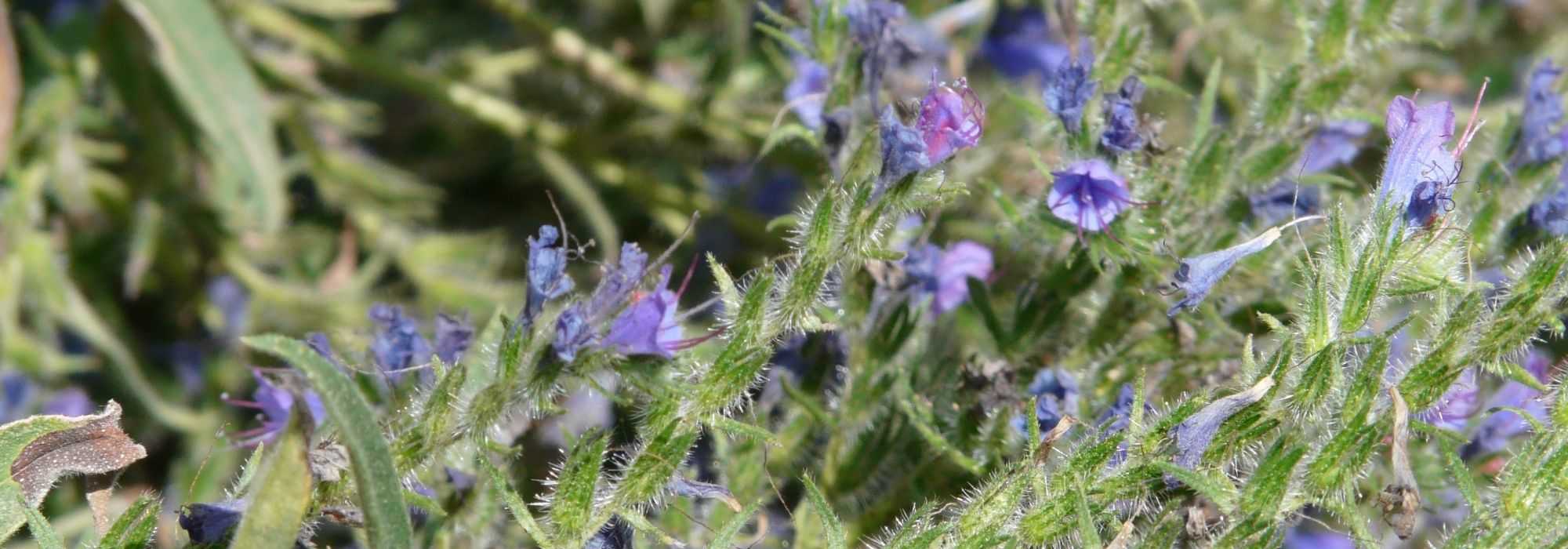
Echium, viper's bugloss: sowing, planting and care
Contents
Echium or Viper's Bugloss, in a nutshell
- Echium, sometimes nicknamed Viper’s herb or Canary viperine, is a very variable plant, herbaceous or shrubby, but short-lived, with flowering in spikes of bright colour often blue.
- Viperine is entirely covered in a fairly coarse down that gives foliage a grey-green, sometimes silvery, hue and makes it resistant to drought and wind.
- Plant forms blue, white, pink or red spikes depending on species, often changing shade with age. Shrubby species such as Canary Echiums produce enormous spikes up to 3–4 m tall.
- Echiums are undemanding plants that self-seed spontaneously in poor, rocky soil and mild climate.
A word from our expert
Shrubby Echiums, sometimes nicknamed the ‘Pride of Tenerife’, have reason to be the pride of the Macaronesian islands of the Canaries and Madeira, which host several endemic species on each island of the archipelago. These Echiums are indeed spectacular plants for their colours and striking forms that leave a strong impression. You may have noticed while walking Brittany’s coastal stretches in spring the impressive 3 m-tall spikes of Echium pininana, a species that dies after fruiting at the end of summer. It is the largest of the viper’s buglosses, nicknamed Tower Jewels, and its natural habitat is on the island of La Palma, although it is fairly rare there and endangered. It is a huge biennial plant with very exotic appearance and character, very easy to grow in areas with only light frosts (−3 to −4°C). It likes heat, full sun, well-drained to arid soils, and may benefit from the shelter of a walled garden, unless grown by the sea.
The species Echium candicans (syn. fastuosum) from Madeira in turn forms a large silvery shrub covered in numerous medium-sized spikes in spring, sky-blue or violet-blue and often very intense in colour. It can live 5–7 years if exposed only to short frosts down to −5°C. The perennial species Echium russicum, less common, is nevertheless hardier (to −10°C) and produces a clump of finer spikes in a handsome crimson-purple, rising from the base. The plant can live for 3–4 years.
Annual or perennial Echiums such as Echium vulgare are much more cold-tolerant (to −15°C) and establish very easily on banks or in dry meadows, even on calcareous ground. Their clumps are much more modest in size, 30–90 cm tall, bearing loose spikes mingling blue and bright pink. The cultivar Blue Bedder, obtained by the cross-breeding of Echium vulgare and Echium plantagineum, is particularly robust, floriferous and fits perfectly in dry, naturalistic gardens but also in a conservatory.
Description and botany
Botanical data
- Latin name Echium
- Family Boraginaceae
- Common name viper's bugloss
- Flowering between April and October depending on species
- Height between 0.30 and 4 m
- Sun exposure sun
- Soil type any loose soil, well drained, even calcareous
- Hardiness good to very low (-15 °C to -3 °C)
Genus Echium, commonly called viper’s bugloss, belongs to family Boraginaceae like comfrey or borage. It includes plants of very different appearance and comprises around sixty species. It consists of annual, biennial and perennial plants, herbaceous or shrubby, all covered with tuberculate bristles and stiff hairs that can sometimes irritate skin.
In biennials such as pininana or vulgare, a plant aged two or three years produces, at the heart of a rosette of narrow silvery-green leaves, one or more panicles of flowers, more or less dense, among which small leaves in the same grey tones, the bracts, are intermixed. This flowering heralds death of the plant which generally self-seeds abundantly in light soil.
Hairy, spiny leaves are alternate, unlike those of sage, and have smooth margins. They form a basal rosette 30–50 cm in diameter that elongates in height in Echium pininana and branches in Echium fastuosum, forming thick cylindrical hairy stems with soft wood. Roots form a deep taproot that makes transplanting somewhat delicate.
Among herbaceous viper’s buglosses, Echium vulgare is a European biennial species, hardy (-15 °C), fairly common in France, found along roads, in meadows, steppes and rocky areas on dry soil, between June and September. Basal leaves are ovate or lanceolate, 10–15 cm long and petiolate, while upper leaves are narrow with a single prominent vein and the lamina attached directly to the stem.
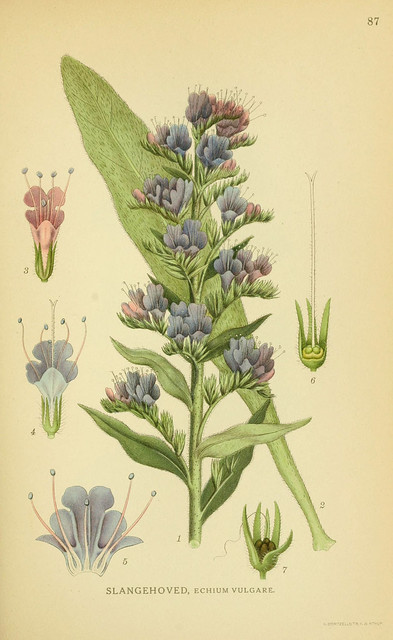
Echium vulgare – botanical illustration
Common viper’s bugloss can form slender bluish spikes up to 1 m tall. Echium plantagineum, more Mediterranean, occurs on sandy sites as far north as Vendée. It is distinguished by heart-shaped basal leaves, softly hairy, and slightly larger flowers up to 3 cm in diameter (2 cm in E. vulgare).
Flowering of Echium is generally springtime in shrubby species while it extends through summer in herbaceous species such as E. vulgare and E. plantagineum. Inflorescences are in the form of oblong panicles composed of bell-shaped, flared flowers 10–20 mm long, most often pink in bud, a vivid blue once corolla develops, then purple when faded. The calyx has 5 lobes and the asymmetrical corolla forms a funnel or a bell with 5 lobes, hairy on the outside. Stamens, often bright pink and protruding from the corolla, number 5 and make flowers sparkle. Pistil, also protruding and white, has an end that splits into 2 points. Flowering of Echium attracts a myriad of pollinating insects — butterflies, bees and bumblebees — which find a bounty for many months. One hectare of viper’s bugloss could produce 400 kg of a delicious honey with a sweet floral scent, a beautiful amber colour and very slow crystallisation.
Dry fruits 2–3 mm are formed of 4 small rough achenes.
Name Echium comes from Latin echis or Greek ekhion, meaning “viper”, referring to seeds shaped like a viper’s head but also to pistil protruding from corolla, evoking bifid tongue of snakes. Trunk of shrubby viper’s buglosses evokes snake’s scaly body. Vernacular name viper’s bugloss has nothing to do with beliefs that plant attracts vipers or cures their bites. However, its dried flowers are used as a medicinal plant, notably for purifying, diuretic and pectoral properties. Seeds of Echium plantagineum contain interesting levels of omega-3 and stearidonic acid with anti-inflammatory properties.
Read also
Coastal garden designMain varieties of Echium
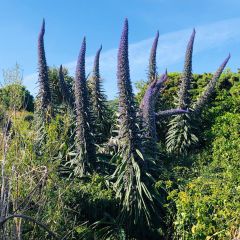
Echium pininana Seeds - Tower of Jewels
- Flowering time August, September
- Height at maturity 3 m
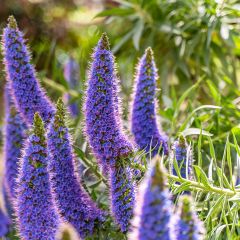
Echium candicans
- Flowering time April to July
- Height at maturity 1,50 m
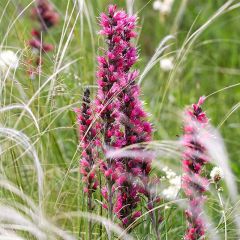
Echium russicum
- Flowering time July to September
- Height at maturity 80 cm
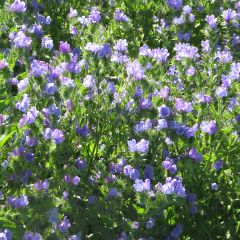
Echium vulgare Blue Bedder Seeds - Vipers Bugloss
- Flowering time August to November
- Height at maturity 30 cm
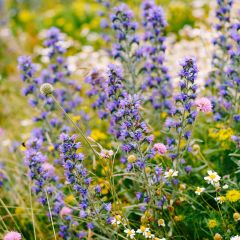
Echium vulgare
- Flowering time May to September
- Height at maturity 90 cm
Discover other Echium - Viper's-buglosses
View all →Available in 2 sizes
Available in 1 sizes
Available in 1 sizes
Available in 1 sizes
Available in 1 sizes
Planting
Where to plant Echium?
Viper’s-buglosses favour warm, sunny locations, in rather dry, poor, sandy, rocky or even calcareous soil, not too acidic and above all very well drained. However, species such as fastuosum and russicum are more vigorous and floriferous in cool, rich soil even though this shortens their lifespan. Under no circumstances do they tolerate more than one season in heavy, compact, wet soil.
Take care with the very low frost tolerance of Macaronesian species such as Echium fastuosum and pininana, which suffer damage from 0°C but may survive short frosts down to around -5°C in perfectly drained, winter-dry soil. You can to grow them in most regions directly in a large pot, because of their low tolerance to transplantation. Echium russicum tolerates down to -10°C in perfectly drained soil and common viper’s-bugloss down to -15°C.
When to plant?
Plant them in September–October in warm climate; otherwise, opt for early spring north of the Loire and in mountains.
How to plant?
In most regions, to grow the large cold-sensitive species in a large pot, because of their substantial growth in a very bright spot such as a conservatory or an unheated greenhouse.
- Add a 10 cm layer of gravel or clay balls to the bottom of the container.
- Make a mix of potting compost, sand and loam.
- In open ground, dig a deep planting hole without smoothing the sides.
- Add sand or compost if necessary to lighten soil and a dose of horn meal if soil is very poor.
- Immerse the rootball in a bucket of water to thoroughly moisten it.
- In heavy soil, choose planting on a raised mound or within a rockery.
- Place the plant in the planting hole without burying the collar.
- Replace soil and firm lightly.
- Water.
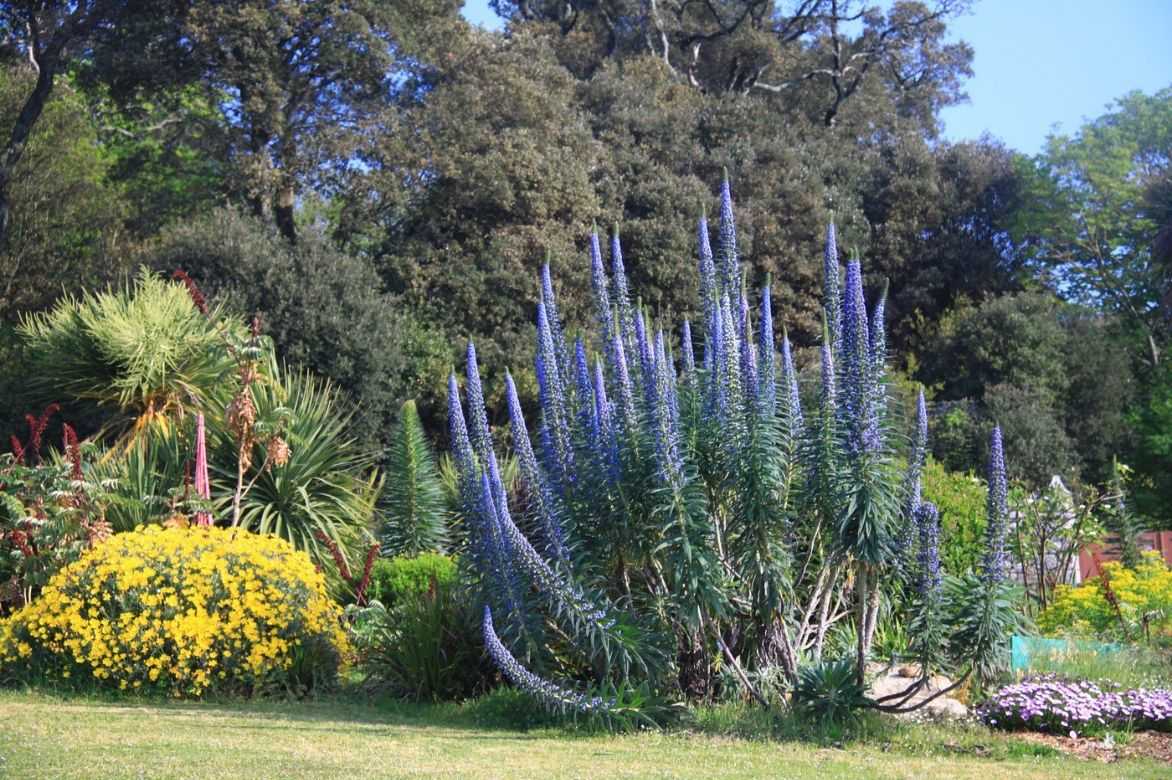
Echium at Jardin des Capucins (29)
→ Also read: Grow Echium in a pot.
Care
- No need to water Echiums in open ground during summer, even in dry climate. In pots, water once or twice a week during growth and more frequently in summer.
- During winter, keep plant in a frost-free, very bright place and water very moderately.
Note, with biennial species such as Echium pininana, plant forms only a compact rosette of foliage during first year following sowing, and it persists over winter. Flowering occurs the following year provided no severe frost below -5°C has destroyed plant.
- Collect seeds from biennial species to carry out new sowings or let nature take its course.
Echiums are not very susceptible to parasitic organisms but watch out for slugs, which are fond of young shoots.
In greenhouse, whiteflies and mites (red spider mites) can invade foliage. It is then advisable to move plant to a well-ventilated, sunny spot during warmer months.
Propagation: propagation by cuttings, sowing
Propagation usually consists of sowing annual, biennial and perennial species. Propagation by cuttings of perennials such as fastuosum and russicum is also possible at any time of year.
Propagation by cuttings
Carry out in August with semi-woody cuttings or at any other time of year.
- Prepare a deep pot by filling it with potting compost mixed with sand.
- Take semi-woody shoot tips 10 cm long that have not borne flowers.
- Remove leaves near base of cutting.
- Insert cuttings to two-thirds of their length, ensuring they do not touch one another.
- Firm compost gently around them to remove air pockets and ensure good contact between potting compost and cutting.
- In autumn, separate rooted cuttings and plant them in buckets which you keep under a cold frame until spring.
Sowing
Self-sowing is quite common in light soil and mild climate. Otherwise, carry out from late May to late July:
- Sow Vipérine seeds 3 mm deep in a special seed compost.
- Germination lasts 7 to 14 days at 18–20 °C.
- Mist regularly to keep substrate moist until germination.
- When large enough to handle, transplant young plants into 7.5 cm diameter pots and overwinter them in an unheated greenhouse, a conservatory or on a well-lit windowsill at about 7 °C.
- Plant outdoors the following spring, spacing plants 1 m apart, in a very sunny site in well-drained, even stony, arid soil.
- Do not overwater this plant; it thrives in dry conditions.
→ Learn more about sowing Echium pininana in our tutorial!
Uses and associations
Echium russicum, vulgare, plantagineum and Blue Bedder are meadow plants that will find their place on slopes, in rockeries, borders and very sunny naturalistic beds alongside poppies, flax, ammis, sainfoin, lucerne, annual cornflowers, phacelia and tuberous pea, Ebenus cretica with its fluffy pink spikes…

An exotic atmosphere in mild climate: Echium fastuosum, Cordyline australis, Agapanthus, Geranium maderense and Osteospermum
Madeira viper’s bugloss (fastuosum) or Canary viper’s bugloss (pininana) make excellent architectural plants for mild Mediterranean or Atlantic coastal gardens as they tolerate sea spray well. They work well on a rocky slope or in a container with exotic plants such as Euryops (yellow daisies), Beschorneria, Agapanthus, Euphorbia mellifera, Melianthus major, large shrubby or perennial salvias such as Salvia leucantha, Salvia canariensis, Salvia guaranitica, Salvia involucrata ‘Bethelii’, Aloe arborescens, rockroses…
Further information
- Discover our range of Echium.
- Discover our ideas for pairing Echium or viper’s bugloss
- Subscribe!
- Contents
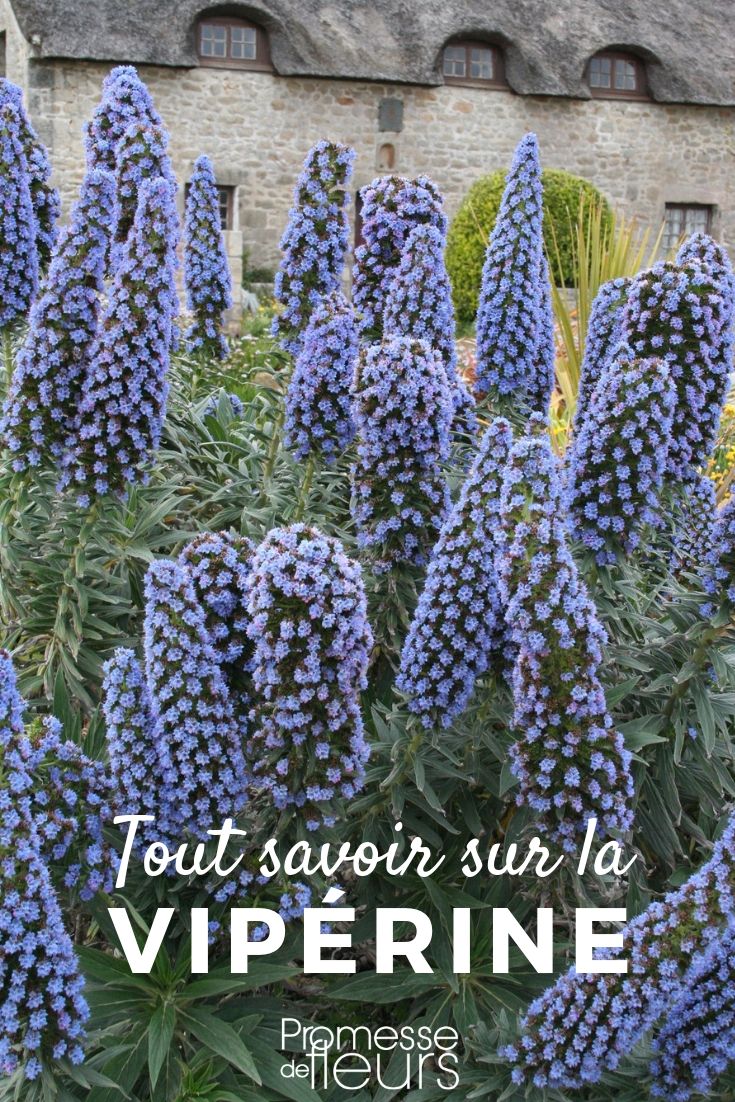































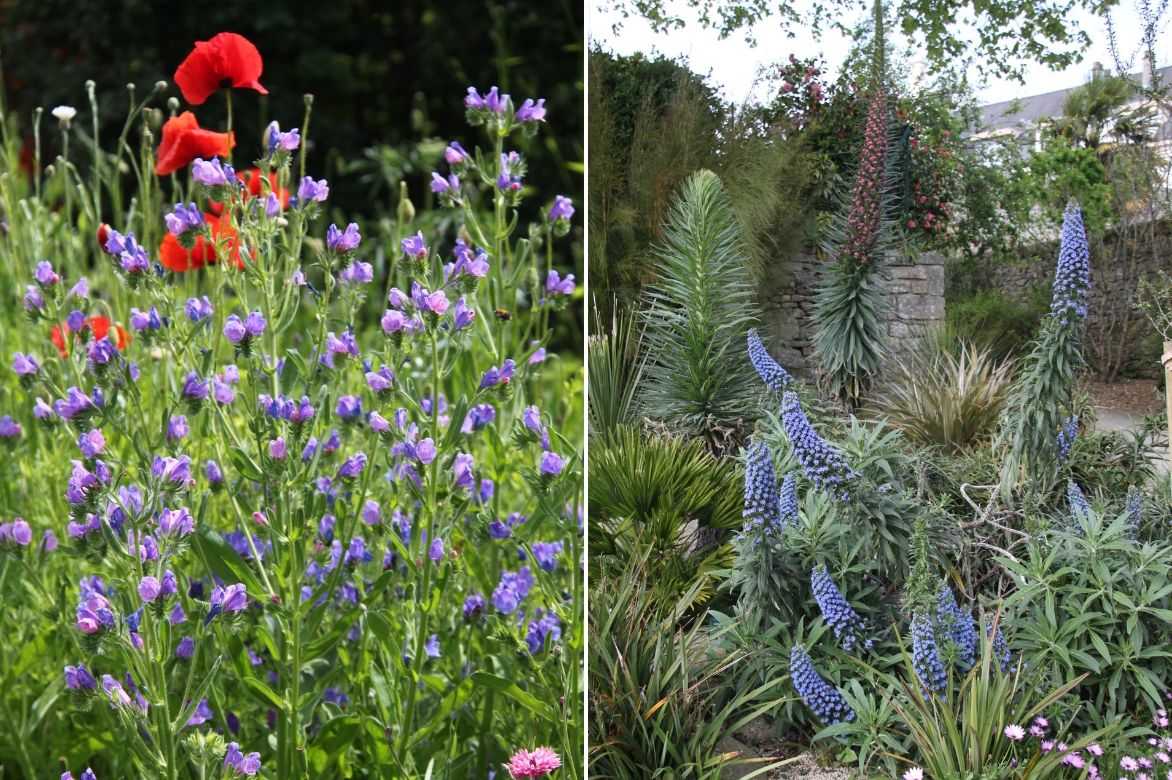




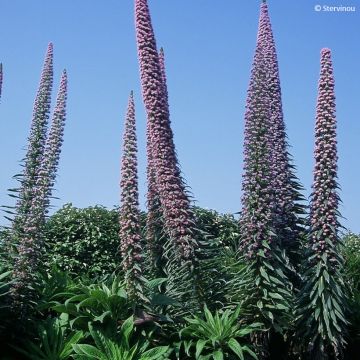
Comments